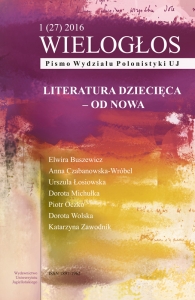„Konstantynku, drogi synku…” Niderlandzkie piśmiennictwo dla dzieci i o dzieciach do końca XVII wieku
„Constantijntje, my dear little son...”. Netherlandish writings for children and about children up to the end of the 17th century
Author(s): Piotr OczkoSubject(s): Visual Arts, Studies of Literature, 16th Century, 17th Century
Published by: Wydawnictwo Uniwersytetu Jagiellońskiego
Keywords: The Netherlands; juvenile literature and writings; iconography; old Netherlandish schoolbooks;
Summary/Abstract: The aim of the given paper is to describe the changes that occurred in the Netherlandish (i.e. Dutch and Flemish) juvenile texts from the Middle Ages up to the end of the 17th century. The introductory remarks focus upon the methodological issues, such as defining the child and its age in the past and the questions concerning the ‘identity’ and possible forms of old literature/ writings aimed for children. In the Netherlands, up to the end of the 16th century, children, were mostly the addressees of the numerous schoolbooks, both Latin and vernacular ones. The revolt against the Spanish rule (1555) resulted in the division of the Netherlands into the Catholic South and the Calvinistic-minded North, namely the Dutch Republic. Whereas in the southern provinces the shape and form of the juvenile writings remained practically unchanged, in the North the publishing market for children grew rapidly, greatly stimulated by the rise of the common education in the Republic, spectacular increase of literacy and the social advancement of the country, based upon the Protestant faith and economical progress. Within few decades young Dutch readers from the North, boys and girls alike, were able to choose from a considerable publishing offer, designed not only for instruction but also for pleasure. Finally, the multitude of representations of children in the 17th century Dutch literature and their contexts (emblem books, conventional didactic and vanitas texts, more personal confessions) have been briefly suggested in the paper.
Journal: Wielogłos
- Issue Year: 2016
- Issue No: 27
- Page Range: 17-39
- Page Count: 23
- Language: Polish

